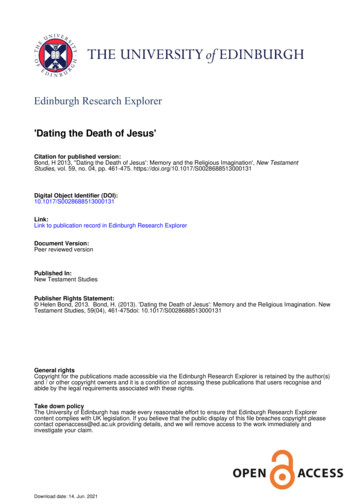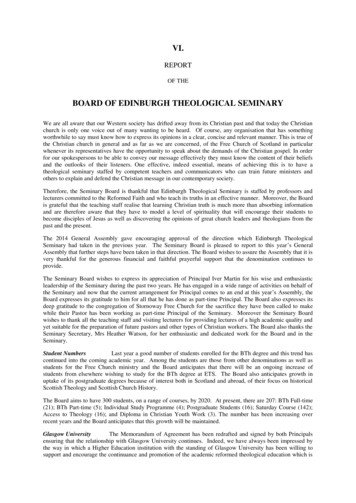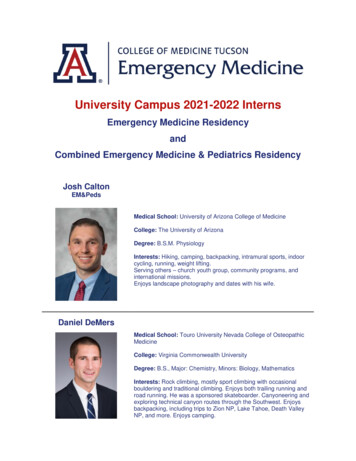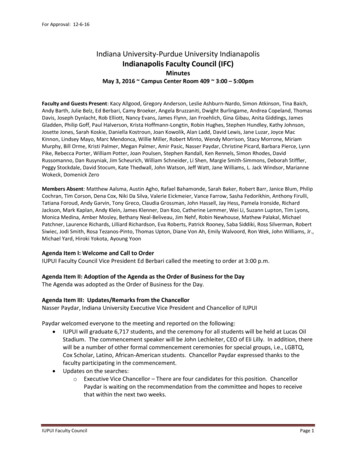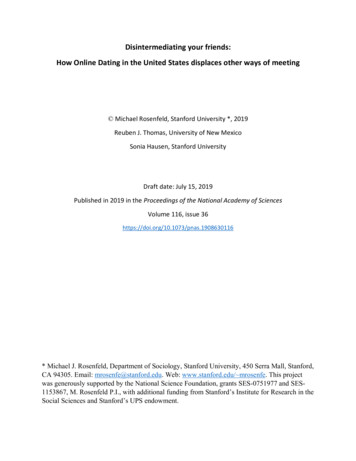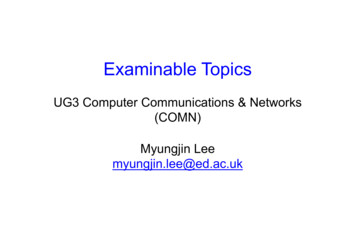
Transcription
Examinable TopicsUG3 Computer Communications & Networks(COMN)Myungjin Leemyungjin.lee@ed.ac.uk
Software-Defined Networking What is SDN? The working mechanism of OpenFlow2
Software-Defined Networking Policy on matching flow entry in OpenFlow– Exact match has the highest priority– All wildcard entries have a priority associated with them– Higher priority entries match before lower priority onesFlow:Src IPSrc PortDst IPDst PortProtocol1.2.3.4100005.6.7.822TCPEntry 1:Entry 2:IPSrcIPDstIPProtTCP TCPPriority Actionsport dport*5.6.7.8***1port6****2210drop3
Software-Defined Networking Example: identifying path of a flow– A flow is defined as srcIP, srcPort, dstIP, dstPort, proto – How many paths exist from Src to Dst?– Assumption: Forwarding rules are written as wildcardsBSrcCDAHEFDstG4
Software-Defined Networking Q: How to determine the path taken by packets ofa flow? A: Do reverse searchBSrcCDAHEFDstG5
Software-Defined Networking Step 1: The controller writes a rule at switch H– Forward packets of the red flow to the controller (Rule1)while giving the rule higher priority than forwarding rules’– It would know that the packets pass switch H Step 2: The controller removes Rule 1BSrcCDAHEFDstG6
Software-Defined Networking Step 3: The controller writes a rule at switches D & G– Forward packets of the red flow to the controller (Rule1)while giving the rule higher priority than forwarding rules’– It would know that the packets pass switch D Step 4: The controller removes Rule 1BSrcCDAHEFDstG7
Software-Defined Networking Step 5: The controller writes a rule at switches C & F– Forward packets of the red flow to the controller (Rule1)while giving the rule higher priority than forwarding rules’– It would know that the packets pass switch F Step 6: The controller removes Rule 1BSrcCDAHEFDstG8
Introduction Understanding of basic concepts and terminologies– Bandwidth (or Capacity)– Throughput– Delay– Loss– BDP (Bandwidth-delay product)– Layering– Encapsulationand so forth9
Introduction Characteristics of packet-switching– statistical multiplexing– store-and-forward– queuing delay and loss Packet switching vs circuit switching– Pros and cons of each switching method10
Packet switching versus circuit switchingpacket switching allows more users to use network!example:§ 1 Mb/s link§ each user: 100 kb/s when “active” active 10% of time 1 Mbps linkcircuit-switching:– 10 users Nuserspacket switching:– with 35 users, probability 10 activeat same time is less than .0004 *Q: how did we get value 0.0004?Q: what happens if 35 users ?* Check out the online interactive exercises for more examples11
Binomial Probability Distribution A fixed number of observations (trials), n– e.g., 20 tosses of a coin Binary random variable– e.g., Head or tail in coin toss– Often called as success or failure– Prob of success is p, and prob of failure is 1-p Constant probability for each observation12
Binomial example Take the example of 5 coin tosses What’s the probability that you flip exactly 3 headsin 5 coin tosses?13
Binomial distribution Solution: One way to get exactly 3 heads: HHHTT What’s the probability of this exact arrangement?– P(heads) x P(heads) x P(heads) x P(tails) x P(tails) (1/2)3 x (1/2)2 Another way to get exactly 3 heads: THHHT– Probability of this exact outcome (1/2) x (1/2)3 x (1/2) (1/2)3 x (1/2)214
Binomial distribution In fact, (1/2)3 x (1/2)2 is the probability of eachunique outcome that has exactly 3 heads and 2tails So, the overall probability of 3 heads and 2 tails is:(1/2)3 x (1/2)2 (1/2)3 x (1/2)2 (1/2)3 x (1/2)2 . for as many unique arrangements as there are But how many are there?15
æ öç è 3ø55C3ways toarrange 3heads in5 trialsOutcomeProbabilityTHHHT(1/2)3 x (1/2)2HHHTT(1/2)3 x (1/2)2TTHHH(1/2)3 x (1/2)2HTTHH(1/2)3 x (1/2)2HHTTH(1/2)3 x (1/2)2THTHH(1/2)3 x (1/2)2HTHTH(1/2)3 x (1/2)2HHTHT(1/2)3 x (1/2)2THHTH(1/2)3 x (1/2)2HTHHT(1/2)3 x (1/2)210 arrangements x (1/2)3 x (1/2)2The probabilityof each uniqueoutcome (note:they are allequal) 5!/3!2! 1016
\P(3 heads and 2 tails) æ5öç è 3øx P(heads)3 x P(tails)2 10 x (½)5 31.25%17
Binomial distribution, generallyNote the general pattern emerging à if you have only twopossible outcomes (call them 1/0 or yes/no or success/failure) in nindependent trials, then the probability of exactly X “successes” n number of trials1-p probabilityof failureX #successes out of ntrialsp probability ofsuccess
Packet switching versus circuit switchingpacket switching allows more users to use network!example:§ 1 Mb/s link§ each user: 100 kb/s when “active” active 10% of time 1 Mbps linkcircuit-switching:– 10 users Nuserspacket switching:– with 35 users, probability 10 activeat same time is less than .0004 *Q: how did we get value 0.0004?Q: what happens if 35 users ?* Check out the online interactive exercises for more examples19
N 35 users Prob (# active users 10) 1 – Prob (#active 10)– Prob (#active 9)– Prob (#active 8) – Prob (#active 0) Prob (#active 10) C(35, 10) * 0.110 x 0.92520
Application layer Client-server vs P2P Transport service requirements depending onapplications TCP service vs UDP service Web and HTTP––––non-persistent vs persistent HTTPResponse timesHTTP CookieWeb caching21
Application layer DNS– The working mechanism of DNS P2P– File distribution efficiency: client-server vs P2P– BitTorrent working mechanism22
Transport layer Demultiplexing– Connectionless– Connection-oriented Reliable transport protocols– Stop-and-wait, Go-back-N, Selective Repeat TCP––––––slow startfast retransmitconnection establishmentcongestion control: AIMDflow controlfairness23
Network layer Longest Prefix Matching Router architecture Subnet: concepts Hierarchical addressing Understanding of DHCP, NAT, ICMP and IPv624
Network layer Routing algorithm– Link State algorithm: Dijkstra's algorithm– Distance Vector algorithm: Bellman-Ford algorithm Hierarchical routing Understanding of RIP, OSPF and BGP25
Link layer Multiple access protocols– channel partitioning (TDMA, FDMA)– random access (Slotted ALOHA, Pure ALOHA, CSMA, CSMA/CD)– "taking turns" (polling, token passing) MAC address and ARP Ethernet– Switch self-learning mechanism Switch vs. Router Error detection (e.g., CRC)26
Multimedia networking Streaming stored videoStreaming live videoContent-Distribution NetworkProtocols for real-time interactive applications– RTP– SIP– H.323 Network support for multimedia applications– DiffServ and IntServ27
myungjin.lee@ed.ac.uk. Software-Defined Networking What is SDN? The working mechanism of OpenFlow 2. Software-Defined Networking Policy on matching flow entry in OpenFlow –Exact match has the highest priority –All wildcard entries have a priority associated with them –Higher priority entries match before lower priority ones 3 SrcIP SrcPort DstIP DstPort Protocol Flow: 1.2.3.4 .
